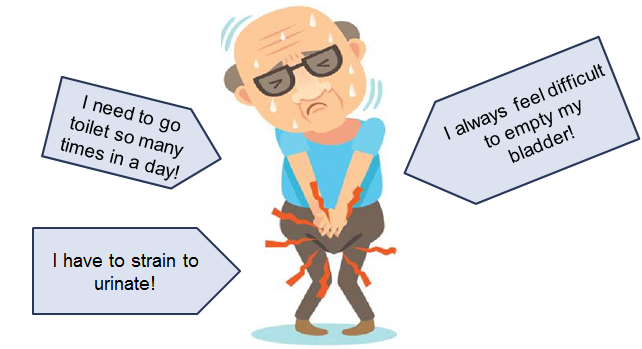Benign Prostatic Hyperplasia

Benign Prostatic Hyperplasia (BPH)
Benign prostatic hyperplasia (BPH) is a condition in men where the prostate gland is enlarged but non-cancerous. As the prostate enlarges, the gland presses and pinches against the urethra. The bladder wall becomes thicker (Figure 1). Eventually, the bladder may become weaken and lose the ability to empty completely, leaving some urine in the bladder.

Figure 1: Normal prostate vs enlarged prostate
BPH affects about 50 percent of men between the ages of 51 and 60 and up to 90 percent of men older than 80, evidence clearly shows that the morbidity of BPH increase with age. In addition, BPH can be induced by a range of risk factors, including obesity, hyperlipidemia, type 2 diabetes, genetic factor and certain hormonal disorders.
The common symptoms of BPH includes:
- Difficulty starting to urinate despite pushing and straining
- A weak stream of urine; several interruptions in the stream
- Dribbling at the end of urination
- A sudden strong desire to urinate
- Frequent urination
- The sensation that the bladder is not empty after urination is completed
- Frequent awakening at night to urinate (nocturia)
- Pain while urinating
How is benign prostatic hyperplasia (BPH) treated?
At present, the primary goals of BPH treatment are to improve quality of life, inhibit disease progression, and reduce complications. BPH is usually treated with alpha-adrenergic blockers and 5-alpha reductase inhibitors. Alpha blocker helps to relax the smooth muscles of the prostate and bladder neck to improve urine flow and reduce bladder blockage. It has faster onset of action so it is recommended as first line treatment for men with mild to moderate symptoms. Examples of alpha blockers are terazosin (Hytrin), doxazosin (Cardura) (Kamiren XL), tamsulosin (Harnal OCAS) and alfuzosin (Xatral). 5-alpha-reductase inhibitors are medicines that can stop the prostate from growing further or even cause it to shrink by decreasing the production of hormone, dihydrotestosterone (DHT) which affects the growth of prostate gland. Finasteride (Proscar) and dutasteride (Avodart) are example of alpha-reductase inhibitors.
Apart from medications, behavioural modifications and therapies may be helpful, particularly as an adjunct to medications. Lifestyle changes include nightly fluid restriction, timed bladder voiding, double-voiding techniques, regular physical activity, pelvic floor muscle training and avoiding caffeine, alcohol, and highly seasoned food.
*Double voiding – it involves passing urine twice each time you go to toilet. Firstly, urinate as usual then wait for 20-30 seconds, urinate again. This technique is effective for those who feel like their bladder is not empty or who return quickly to the bathroom after voiding.
Natural remedies for enlarged prostate (BPH)
- Saw palmetto
Remedy that comes from fruit of palm tree. It is an inhibitor of 5 alpha reductase. It has anti-inflammatory and hormone-blocking properties. Saw palmetto is used to relieve urinary symptoms caused by benign prostatic hyperplasia (BPH).
- Pygeum bark
It contains a wide range of fatty acids, alcohols and sterols such as beta-sitosterol. It has an antioxidant and anti-inflammatory effect on urogenital system. Able to improve symptoms of benign prostatic hyperplasia.
- Tomato
It consists of lycopene, a powerful antioxidant that protect cells from damage and improve prostate health.
- Pumpkin seed
It consists of zinc which is able to decrease the production of dihydrotestosterone (DHT) and inhibit this androgen from binding to receptors, potentially reducing BPH symptoms.
- Cranberry
It contains phytonutrients with anti-inflammatory properties. It is used to prevent bladder and urinary tract infection by preventing bacteria from sticking to the wall of the bladder. Shown improvement in urinary flow.
References:
- Information H, Diseases U, Problems P, Hyperplasia) P, Hyperplasia) P, Health N. Prostate Enlargement (Benign Prostatic Hyperplasia) | NIDDK [Internet]. National Institute of Diabetes and Digestive and Kidney Diseases. 2021 [cited 18 October 2021]. Available from: https://www.niddk.nih.gov/health-information/urologic-diseases/prostate-problems/prostate-enlargement-benign-prostatic-hyperplasia
- Egan K. The Epidemiology of Benign Prostatic Hyperplasia Associated with Lower Urinary Tract Symptoms. Urologic Clinics of North America. 2016;43(3):289-297.
- Calogero A, Burgio G, Condorelli R, Cannarella R, La Vignera S. Epidemiology and risk factors of lower urinary tract symptoms/benign prostatic hyperplasia and erectile dysfunction. The Aging Male. 2018;22(1):12-19.
- Yoo S, Oh S, Park J, Cho S, Cho M, Jeong H et al. The impacts of metabolic syndrome and lifestyle on the prevalence of benign prostatic hyperplasia requiring treatment: historical cohort study of 130 454 men. BJU International. 2018;123(1):140-148.
- Yu Z, Yan H, Xu F, Chao H, Deng L, Xu X et al. Efficacy and Side Effects of Drugs Commonly Used for the Treatment of Lower Urinary Tract Symptoms Associated With Benign Prostatic Hyperplasia. Frontiers in Pharmacology. 2020;11.
- Fonseca J, Martins da silva C. The diagnosis and treatment of lower urinary tract symptoms due to benign prostatic hyperplasia with α-blockers: focus on silodosin. Clin Drug Investig. 2015;35(suppl 1):7-18.
- 10 natural remedies for enlarged prostate and lifestyle tips [Internet]. Medicalnewstoday.com. 2021 [cited 4 November 2021]. Available from: https://www.medicalnewstoday.com/articles/321231#lifestyle-tips




